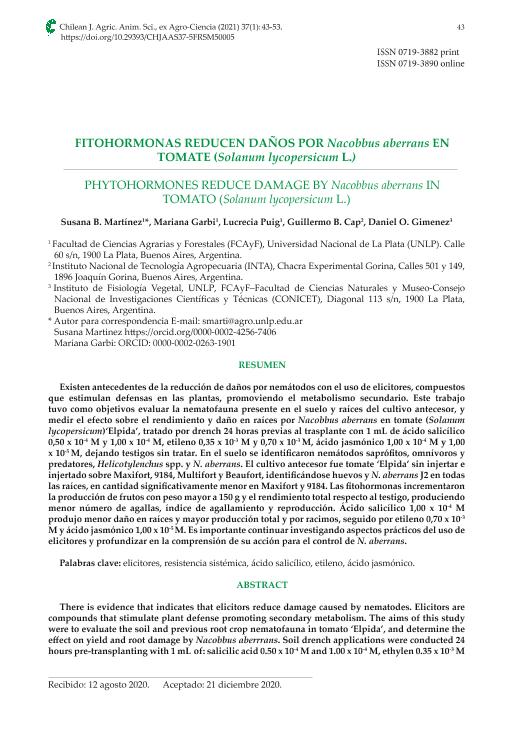Artículo
Existen antecedentes de la reducción de daños por nemátodos con el uso de elicitores, compuestos que estimulan defensas en las plantas, promoviendo el metabolismo secundario. Este trabajo tuvo como objetivos evaluar la nematofauna presente en el suelo y raíces del cultivo antecesor, y medir el efecto sobre el rendimiento y daño en raíces por Nacobbus aberrans en tomate (Solanum lycopersicum)‘Elpida’, tratado por drench 24 horas previas al trasplante con 1 mL de ácido salicílico 0,50 x 10-4 M y 1,00 x 10-4 M, etileno 0,35 x 10-3 M y 0,70 x 10-3 M, ácido jasmónico 1,00 x 10-4 M y 1,00 x 10-5 M, dejando testigos sin tratar. En el suelo se identificaron nemátodos saprófitos, omnívoros y predatores, Helicotylenchus spp. y N. aberrans. El cultivo antecesor fue tomate ‘Elpida’ sin injertar e injertado sobre Maxifort, 9184, Multifort y Beaufort, identificándose huevos y N. aberrans J2 en todas las raíces, en cantidad significativamente menor en Maxifort y 9184. Las fitohormonas incrementaron la producción de frutos con peso mayor a 150 g y el rendimiento total respecto al testigo, produciendo menor número de agallas, índice de agallamiento y reproducción. Ácido salicílico 1,00 x 10-4 M produjo menor daño en raíces y mayor producción total y por racimos, seguido por etileno 0,70 x 10-3 M y ácido jasmónico 1,00 x 10-5 M. Es importante continuar investigando aspectos prácticos del uso de elicitores y profundizar en la comprensión de su acción para el control de N. aberrans. There is evidence that indicates that elicitors reduce damage caused by nematodes. Elicitors are compounds that stimulate plant defense promoting secondary metabolism. The aims of this study were to evaluate the soil and previous root crop nematofauna in tomato ‘Elpida’, and determine the effect on yield and root damage by Nacobbus aberrrans. Soil drench applications were conducted 24 hours pre-transplanting with 1 mL of: salicilic acid 0.50 x 10-4 M and 1.00 x 10-4 M, ethylen 0.35 x 10-3 M and 0.70 x 10-3 M, jasmonic acid 1.00 x 10-4 M and 1.00 x 10-5 M, including untreated plants as control. In the soil, saprophytic, omnivorous and predatory nematodes, as well as Helicotylenchus spp. and N. aberrans, were identified. The previous crop was ungrafted ‘Elpida’ plants and also grafted on Maxifort, 9184, Multifort and Beaufort. Eggs and N. aberrans J2 were identified in all roots, with significantly lower amounts in Maxifort and 9184. Phytohormones increased the production of fruits with weight higher than 150 g and total yield compared to the control, producing lower galls, galling and reproductive indexes. Salicylic acid 1.00 x 10-4 M produced lower damage to the roots and a higher total yield and truss yield, followed by ethylene 0.70 x 10-3 M and jasmonic acid 1.00 x 10-5 M treatments. Further research is required to provide deeper knowledge of the practical implications of using elicitors and enhance the understanding of their action for N. aberrans control.
Fitohormonas reducen daños por Nacobbus aberrans en tomate (Solanum lycopersicum L.)
Título:
Phytohormones reduce damage by Nacobbus aberrans in tomato (Solanum lycopersicum L.)
Fecha de publicación:
04/2021
Editorial:
Universidad de Concepción
Revista:
Chilean Journal of Agricultural and Animal Sciences
ISSN:
0719-3882
e-ISSN:
0719-3890
Idioma:
Español
Tipo de recurso:
Artículo publicado
Clasificación temática:
Resumen
Palabras clave:
ELICITORS
,
SYSTEMIC RESISTANCE
,
SALICYLIC ACID
,
ETHYLENE
,
JASMONIC ACID
Archivos asociados
Licencia
Identificadores
Colecciones
Articulos(CCT - LA PLATA)
Articulos de CTRO.CIENTIFICO TECNOL.CONICET - LA PLATA
Articulos de CTRO.CIENTIFICO TECNOL.CONICET - LA PLATA
Articulos(INFIVE)
Articulos de INST.DE FISIOLOGIA VEGETAL
Articulos de INST.DE FISIOLOGIA VEGETAL
Citación
Martinez, Susana; Garbi, Mariana; Puig, Maria Lucrecia; Cap, Guillermo; Gimenez, Daniel; Fitohormonas reducen daños por Nacobbus aberrans en tomate (Solanum lycopersicum L.); Universidad de Concepción; Chilean Journal of Agricultural and Animal Sciences; 37; 1; 4-2021; 43-53
Compartir
Altmétricas




